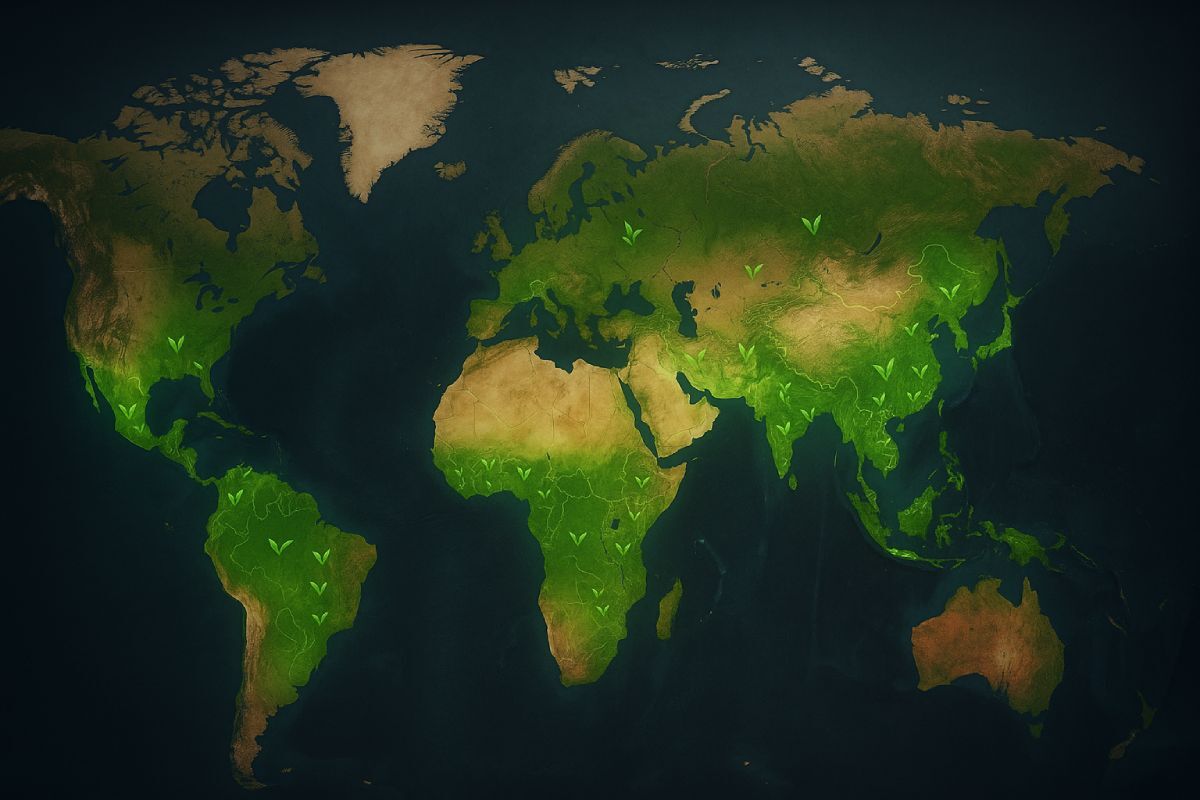
The journey of tea from a simple leaf to the perfect cup is a story of geography, climate, and culture. While the Camellia sinensis plant is the source of all true teas, its final character—the aroma, flavor, and body—is profoundly shaped by its terroir. This concept, borrowed from the world of wine, refers to the unique combination of a region's climate, soil, altitude, and traditions.
Tea flourishes in specific conditions: acidic soil, high humidity, significant rainfall, and mountainous terrain. These conditions are found in a band of countries across Asia, Africa, and South America. Join us on a tour of the world's most important tea-growing regions to discover how the misty mountains of China or the volcanic slopes of Kenya create the teas you love.
The Birthplace of Tea: China
As the undisputed origin of tea, China boasts the most diverse range of tea types in the world, from delicate white teas to earthy, aged Pu-erhs. For centuries, it was the only country that cultivated tea. Today, it is the world's largest tea producer, with a vast landscape of distinct tea-growing provinces.
- Yunnan: Known as the "cradle of tea," this high-altitude, mountainous province is famous for its rich, smooth, and malty black teas (Dian Hong) and its unique, post-fermented Pu-erh teas.
- Fujian: This coastal province is a powerhouse of tea production, famous for its legendary oolong teas (like Tie Guan Yin from Anxi) and the world's first black tea, Lapsang Souchong. It is also the birthplace of white tea.
- Zhejiang: Home to the most famous Chinese green tea, Dragon Well (Longjing), this province is renowned for its exceptional pan-fired green teas with a signature nutty, sweet flavor.
- Anhui: This province is best known for producing Keemun, one of the world's most famous black teas, celebrated for its complex aroma with notes of orchid and stone fruit.
The Giant of the Industry: India
Introduced to tea cultivation by the British in the 19th century, India has become a global giant, currently standing as the second-largest tea producer. Its teas are famous for their strength, boldness, and complexity, with three iconic regions leading the way.
- Darjeeling: Nestled in the Himalayan foothills, Darjeeling produces teas often called the "Champagne of Teas." Grown at high altitudes, these teas are light, floral, and possess a unique muscatel (grape-like) flavor that cannot be replicated anywhere else in the world.
- Assam: Located in the hot, humid lowlands of the Brahmaputra River valley, Assam is the world's largest tea-growing region by area. It is famous for producing strong, bold, and malty black teas that form the base of many "English Breakfast" blends.
- Nilgiri: The "Blue Mountains" of Southern India produce teas that are wonderfully fragrant, fruity, and brisk. They are less astringent than other Indian teas and are perfect for making iced tea as they don't turn cloudy when chilled.
The Island of Tea: Sri Lanka (Ceylon)
Formerly known as Ceylon, Sri Lanka is renowned for producing clean, crisp, and citrusy black teas. The island's diverse microclimates and elevations create a variety of distinct flavor profiles, which are often classified by the altitude at which they are grown.
- High-Grown (e.g., Dimbula, Nuwara Eliya): Teas grown over 4,000 feet are light, floral, and delicate.
- Mid-Grown (e.g., Kandy): These teas have a fuller body and rich flavor.
- Low-Grown (e.g., Ruhuna): Known for producing strong, robust teas with a deep color.
The Master of Green Tea: Japan
Japan focuses almost exclusively on producing green tea, which is deeply woven into its culture. The Japanese have perfected a unique method of steaming the tea leaves immediately after harvest to halt oxidation, resulting in a distinctively savory, oceanic, and vegetal flavor profile (often described as "umami").
- Sencha: The most popular tea in Japan, known for its fresh, grassy flavor.
- Matcha: A finely powdered, shade-grown green tea famous for its use in the traditional Japanese tea ceremony.
- Gyokuro: A premium, shade-grown tea with a deep, sweet, and intensely savory flavor.
The Oolong Specialist: Taiwan (Formosa)
Formerly known as Formosa, Taiwan is celebrated for producing some of the world's finest and most complex oolong teas. The island's mountainous terrain and humid, subtropical climate are ideal for creating these partially oxidized teas, which range from light and floral to dark and roasty.
The Emerging Powerhouse: Africa
Tea cultivation in Africa is relatively recent, but the continent has quickly become a major force in the global market. Kenya is the world's largest exporter of black tea, known for producing strong, bright, and brisk teas that are a staple in many commodity tea bags. Other significant African producers include Malawi, Uganda, and Rwanda, which is gaining a reputation for high-quality specialty teas.
Frequently Asked Questions About Tea Regions
Which country produces the most tea in the world?
China is the world's largest producer of tea, cultivating a vast and diverse range of green, oolong, white, black, and Pu-erh teas.
What gives Darjeeling tea its unique 'muscatel' flavor?
The unique flavor of Darjeeling is a result of its specific terroir: high altitude, cool misty climate, and unique soil conditions in the Himalayan foothills. It is also influenced by a specific species of leafhopper insect that nibbles on the tea leaves, triggering a defensive chemical reaction that creates the prized muscatel notes.
Which country is most famous for green tea?
While China produces the largest quantity of green tea, Japan is arguably the most famous for its specialized and culturally significant green teas like Matcha, Sencha, and Gyokuro, known for their distinct savory "umami" flavor.
What is the difference between tea from China and tea from India?
The primary difference comes from the plant varietal and processing. Many Indian teas (especially from Assam) are made from the Camellia sinensis assamica varietal, which produces a bold, malty flavor. Chinese teas often use the Camellia sinensis sinensis varietal and a wider range of processing methods, resulting in a more diverse spectrum of flavors, from grassy green teas to earthy Pu-erhs.
